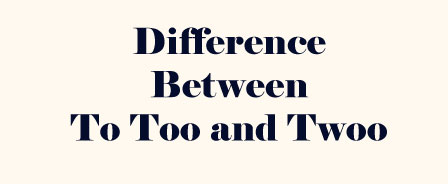In this Section we will look at the difference between to, too and two.
TO
To means in the direction of or towards something.
TO is a preposition. It indicates the place you arrive at as a result of moving.
You go from A to B
Examples:
- I went to the beach.
- I will take a taxi to the airport.
- We're going to the stadium tonight.
TO refers to the end point of a time period. You usually say from X to Y.
Examples
- She works from 9 to 5.
- I work from Monday to Friday.
- We watched it from beginning to end.
Note: If we do not have the starting time, we use UNTIL. I work until 5:00.
TO identifies the person receiving something.
- I gave the gift to my friend.
- Can you give my keys to Daniel?
- She was very nice to us.
TO can be used to show a change of state, condition or quality.
- The sword has turned to rust.
- She tore the secret message to pieces.
- The traffic light changed from red to green.
TO is also the first part of an infinitive. Infinitive is TO + VERB. An infinitive is the basic form or the original form of a verb like TO BE, TO GO, TO EAT.
Notice that when two verbs are together, the second verb is in the infinitive form, except with modal verbs and TO BE.
Example:
I like to sing.
There are two verbs. Verb 1 is like and verb 2 is sing.
Since we have two verbs together, the second verb verb to sing is in its infinitive form to sing. The TO is necessary between the two verbs.
Examples.
- I like to play the guitar.
- We have to buy a dictionary.
- She likes to ride her bike.
TOO
TOO can be used before an adjective or an adverb and means more than is needed, more than desirable or more than is wanted.
Examples:
- This shirt is too big for me.
- Slow down! You're driving too fast.
- It is too cold to go swimming today.
TOO also refers to an excessive amount of something and it is often followed by much or many.
Too much before an uncountable noun and Too many before a plural noun.
Examples:
- You put too much salt in the soup.
- I can't go I have too much work to do.
- There were too many people in the room.
TOO can also mean ALSO, in addition or as well. There is not a much difference between too and also. they. They are same.
- I'm thirsty too / It means I am also thirsty.
- We would like some cake too. / Yes, we would like some cake in addition to the coffee.
- I was tired last night and my friend was too. / My friend was also tired.
TWO - This is the easiest.
This is a number. It is only used as a number. One, TWO, three. We can see a picture of two birds. Let's look at some examples.
- I can speak two languages.
- A bicycle has two wheels.
- He ate two hamburgers.
Sometimes TO, TOO and TWO can all be used in the same sentence. While they all sound the same, it is the context that helps you understand the meaning of each.
Example:
- I want to go to two places too.
- The first TO is necessary because we have two verbs together. Verb 1 want and Verb 2 go.
- The next TO shows us the direction we are going. I want to go in this direction. I want to go TO a place somewhere.
- The next TWO is a number. I want to go not only to one place but two places.
The final TOO means ALSO. I also want to go to two places just like you.











Wao good explained. Have searched online about the difference of to and too but not got briefd. Now its clear.. thanks
ReplyDelete